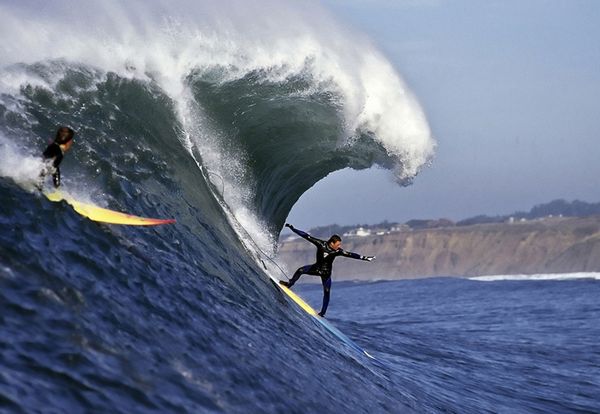Paddling beyond the white water
When you get comfortable riding and making some directional changes choose a day, when the conditions allow for paddling out to an area where you can catch unbroken waves. This can be done on a foam board for the first time, or a suitable custom board that you have practised on. For the first paddle out you should look for clean one to two foot conditions. Anything bigger and it will be too hard to learn anything or even get out there. Take someone more experienced with you or use an instructor’s guidance in a lesson.
Clean is to say that the waves are unaffected by onshore winds forming smooth, well spaced lines across the beach. Avoid strong offshore winds to start with as they complicate takeoff and may take you out to sea!
To navigate the waves successfully it is not about Brute strength, more interpretation, patience, and timing. Spend some time observing the route of others entering the water and of course assess the size and conditions of the day. For the first outing you will not be able to duck dive under the waves, especially on a larger board or Softboard. So, instead point your board out to sea after wading to a suitable depth and jump on before a wave gets to you, in a lull between the waves.
Start to paddle at a rate of roughly one stroke every one and a half seconds, head up off the board looking out to sea, toes clear and up out of the water. As a wave approaches place your hands on the rails, level with your chest, in order to push up and let the wave wash below your body and over the deck of the board. This will stop you getting pushed back by a wave.
If the white water is too big ask yourself if you are ready for these conditions? If you are, take a big breath, navigate oncoming white water using a turtle roll. I.e. keep hold of the rails tightly so that the base is now out of the water and you are underwater on your back, thrust the nose into the wave and frog kick to help you through. As the wave passes roll back over and mount the board to continue the paddle out.
On smaller boards and with lots of practise which may amount to many seasons, the most effective way to get through a wave is to duck-dive. This is a very tricky technique to get to grips with and you will need some guidance. In simple terms the nose of the board is forced down under the wave then the tail is pushed through after it by your feet, resurfacing the other side of the passing wave, nose first.
It is entirely possible to get out the back without using duck diving, instead timing, and choosing the correct area to paddle out.
Once you make it beyond the breaking waves sit up on the middle of your board legs dangling in the water either side. This will be hard at first. Use your feet in a treading water motion to stabilise you, as well as your hands if need be. Now you can catch your breath and look for a wave to catch.
Practise turning the board while sitting down, since it takes longer turning when lying down. Pull the board round from your viewing position, to point towards the beach when you see a wave approach at fifteen to twenty foot behind you.
Build up a deep paddling stroke to get speed. As the wave comes around the tail of the board lift up your chin and feet, arching your back, whilst really driving the water back with your hands as hard as you can. Only when you feel the board start to slide down the face of the wave should you grab the rails and jump as quick as you can to your feet. Don’t hesitate just do it! Go into automatic. Your muscles will remember how from all the practice you have put in, on the inside. If you take too long the board will be heading straight down and the wave will devour you!
TIPS!; When lying down learn to use the muscles in your stomach and upper legs to correct any balance adjustments. The nearer you can place your hands to your ribs the easier it will be to jump up.

Paddling beyond the white water
Comments
13 responses to “Paddling beyond the white water”
-
enclomiphene with overnight fedex
discount enclomiphene buy virginia
-
kamagra sans ordonnance canada
kamagra australie générique en ligne
-
order androxal next day delivery
order androxal without rx
-
online order flexeril cyclobenzaprine uk online
how to order flexeril cyclobenzaprine price singapore
-
dutasteride achat
online order dutasteride usa generic
-
cheapest buy fildena canadian discount pharmacy
fildena fedex without prescription
-
purchase gabapentin generic pharmacy canada
get gabapentin purchase usa
-
buying itraconazole generic when available
buy cheap itraconazole usa drugstore
-
staxyn from canada without a prescription
brand staxyn online
-
how to order avodart generic uk buy
buy cheap avodart generic efficacy
-
ordering xifaxan australia to buy
buy cheap xifaxan cheap canada pharmacy
-
ordering rifaximin generic for sale
buying rifaximin generic does it work
-
comprar kamagra contra reenbolso
kniha koupit online objednávku kamagra
Leave a Reply
You must be logged in to post a comment.